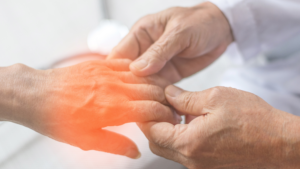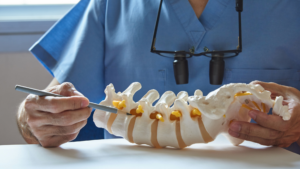Degenerative disc disease (DDD) describes a group of symptoms that results from age-related wear-and-tear of the spinal discs. It could also be a result of an acute spinal injury that causes the spinal column to deteriorate or break down.
Despite its name, degenerative disc disease is, in fact, not a disease. This is a natural occurrence that is a result of aging. The rubber-like discs between the vertebrae that act like shock absorbers allow for bending and flexing of the back. Overtime, they become worn out and are unable to provide the highest level of protection. MRIs show some deterioration of the spine in the majority of patients over the age of 60.

How to Treat Degenerative Disc Disease
Symptoms of DDD
Symptoms are dependent on which disc is degenerated. The most common early sign is pain and weakness in the back that oftentimes radiates to another area. The pain can be weak to the point where it is almost nonexistent or very severe, preventing a person from continuing daily activities. Even if a person typically only has weak or dull pain, they may experience flare ups of extremely intense pain.
Pain may worsen throughout the day, due to bending, sitting, standing, and walking. Changing positions and continuing to move carefully can help prevent the pain from getting more intense.
The pain begins with damage in the spine, but overtime, the discomfort can result in other conditions such as osteoarthritis. Because the pain radiates to other areas of the body, people tend to feel pain and discomfort in their buttocks and upper thigh and tingling in the legs or feet.
When the degenerated disc is in the cervical spine, the neck area, the pain can radiate to the shoulder, arm, or hand.
Another symptom that is possible is for people to experience spinal instability, leading to muscle spasms in the lower back as the body tries to correct and stabilize the vertebrae. These spasms can be very painful.
Treatment Options for Degenerative Disc Disease
Treatment for degenerative disc disease generally begins with nonsurgical methods. Your doctor will determine the severity of the condition and recommend treatment methods based on your individual pain.
Nonsurgical Treatments Options
- Medications: Your physician may suggest taking NSAIDs or over-the-counter pain relievers such as aspirin or ibuprofen. These help inflammation that can ease your pain and lessen swelling.
- Physical Therapy: A physical therapist can help teach proper exercises to strengthen and stretch the correct muscles that help the back heal. Learning movement modifications to everyday tasks can help prevent painful flare-ups. Specific movements make the muscles in the neck and back stronger and more flexible, allowing better spinal support.
For most patients, physical therapy, in conjunction with pain medication, is enough long-term pain relief.
Surgical Treatment Options
If noninvasive treatment options do not work or if a person continues to experience severe pain, your physician may recommend surgery.
Surgery may include the removal of the degenerated disc, which is then replaced with a new disc. Another option is a partial disc removal (discectomy) to help relieve pressure from your nerves.
If there is a severe issue, your doctor may permanently connect (fuse) the bones in your spine after the disc is removed. This will reduce the movement in the damaged area.
Along with following your doctor’s treatment recommendations, self-care goes a long way in reducing pain and strengthening your spine. Physical activity and healthy lifestyle choices like a balanced diet, reducing mental and emotional stress, and stopping smoking have profound effects on this type of musculoskeletal condition.
If you have back pain or are suffering from degenerative disc disease, fill out the form below to get in touch wth the team at Progressive Pain Management.
Neuropathic pain is a type of pain where the cause is not found in an organ or tissue and can occur in any part of the body. This type is most common in the limbs but can also occur in joints, stomach, or elsewhere. It occurs when nerve cells are damaged or injured, sending signals to be felt as pain, usually through burning, prickling, and tingling sensations. Neuropathic pain can be complicated to treat because it cannot always be easily located like other types of pain.

Things to Know About Neuropathic Pain
Causes of Neuropathic Pain
Nerve Damage or Injury
Neuropathic Pain can occur when the nerve cells are damaged or injured. This may happen as a result of disease or damage to the nerves. It may also occur when the protective covering surrounding the nerve fibers are damaged.
Degeneration
Neuropathic Pain can be caused by degeneration of specific brain cells or spinal cord cells, which send pain signals to the brain. This type of Pain is often due to dementia, Parkinson’s disease, multiple sclerosis, spinal injury, and diabetes.
Compression of the Spinal Cord
Occurs when a person is experiencing a fracture or vertebral compression in the neck, chest, or back. The most common Pain that can occur with this maintenance is referred to as radiculopathy and is characterized by sharp shooting pains that run down the arms, legs, and back.
How to treat neuropathic Pain
The main goal of treating neuropathic Pain is to manage the pain as much as possible and to reduce the side effects of the treatment. People with neuropathic Pain may be referred to standard medication such as:
Opioids
A class of drugs that relieve Pain by suppressing the central nervous system’s response to pain signals. Examples include hydrocodone (Vicodin) and codeine. Medications like these slow the nerves down, making them less sensitive to pain signals.
Anticonvulsant
These medicines constrict the muscles in the brain by reducing abnormal neuron activity or abnormal neuron growth. Examples include carbamazepine (Tegretol), valproic acid (Depakote) and gabapentin (Neurontin).
NSAIDs(Non-steroidal anti-inflammatory drugs)
These painkillers are most commonly used to treat inflammation and swelling, but they also reduce the effects of nerve damage by suppressing the central nervous system’s response to pain signals.
Acupuncture
Acupuncture is a method that involves placing wonderful needles into acupuncture points and in the back to try to curb pain signals from being sent out. Acupuncture can help reduce a person’s sensitivity to Pain by blocking the nerves and nerve pathways.
Transcutaneous electrical nerve stimulation (TENS)
Treatment involves placing electrodes on the skin and pressing them to send signals to particular nerve pathways. TENS can be used as a treatment for Pain that conventional therapies cannot control.
Rehabilitation
When Pain becomes severe and chronic, severe Pain should be treated first. Treatments after that may include rehabilitation therapies. These include physical therapy, which can help improve mobility and strength, cognitive behavioral therapy, which can help to decrease stress and anxiety related to Pain, and psychotherapy, which can also help reduce stress as well as depression or other emotional problems related to the Pain or different multidisciplinary approaches such as educational programs.
Final Thoughts
Neuropathic Pain is a type of Pain that many people suffer from at one point in their lives. In most cases, Pain can be managed with various treatments and medications.
If you suffer from neuropathic pain that conventional treatments cannot control, Progressive Pain Management is here to help you. Fill out the form below to contact our team for further queries.
Have you or a loved one been experiencing chronic pain for months in your lower body? If so, you may want to consider DRG Therapy, a new treatment method for chronic pain. This blog post explains what DRG Therapy is, who’s a good candidate for it, what you can expect from the treatment, and the next steps you can take.

DRG Therapy for Chronic Pain
What is DRG Therapy?
DRG Therapy stands for Dorsal Root Ganglion Stimulation therapy. According to Penn State Health, a dorsal root ganglion is a collection of sensory neurons at the dorsal root of a spinal nerve. DRGs act like traffic lights, managing the signals and sensations that travel along the spinal column to the brain.
DRG therapy is a type of neurostimulation therapy. This means using invasive and noninvasive techniques and the application of electrical stimulation to drive neural function. Stimulation can ease the pain in specific locations. DRG Therapy is for managing chronic pain in specific areas of the lower body like your:
- foot
- knee
- hip
- pelvis
- groin
While there isn’t a cure for isolated chronic pain, DRG therapy can provide some much-needed relief in those areas. It’s particularly beneficial for those who suffer from chronic pain in the pelvis and lower body.
Are You a Candidate?
You may want to consider DRG therapy if you’re experiencing:
- Chronic pain in a lower part of the body, like your foot, knee, hip, or groin after an injury or surgery.
- Chronic pain that lasts six months or more.
- Minimal or no relief from pain management therapies or traditional neurostimulation, medications, or surgery.
- Only partial relief from other therapies.
What Can You Expect from This Treatment?
The therapy involves a physician implanting a temporary and removable device, i.e., the DRG stimulator. The doctor will work with you to try out the device to see if it can effectively manage your pain before they implant it.
Once implanted, the physician uses a patient “remote control” to send mild electrical pulses from the stimulator to your dorsal root ganglia. The result should be pain relief in the targeted area.
Relieve Chronic Pain and Take Back Your Life
No one should live with continual, daily pain. DRG Therapy is unique because it’s a spinal stimulation concentrating on the lower body area. Relieve the pain so you can live the happy, productive life you deserve.
If you or a loved one has been experiencing chronic pain and are interested in DRG Therapy, Progressive Pain Management is here to help. In addition to DRG Therapy, we offer a wide variety of other pain management treatments and programs. Contact us today, and we’re happy to answer your questions about pain management and help you set up an appointment.
Are you tired of dealing with back pain that just never goes away? The truth is, chronic back pain can be debilitating and difficult to manage. While many different treatments are available to help control your symptoms, radiofrequency lesioning may provide an effective solution.
Radiofrequency lesioning uses high-frequency electrical signals to deliver targeted heat directly to the source of your pain to create a small ablation or “lesion,” which can reduce discomfort for long-term relief. Keep reading to learn more about how radiofrequency lesions work, what they treat, and whether they are right for you.

Using Radiofrequency Lesioning to Treat Back Pain
What is Radiofrequency Lesioning?
Radiofrequency lesioning (RFL) is an invasive procedure to reduce chronic neck or back pain. During a radiofrequency ablation procedure, a doctor uses fluoroscopy (a live x-ray) to guide an electrode needle into the nerve that carries the pain signals from your spine to your brain. The electrode sends radio frequency energy through the needle, creating a small “lesion” that interrupts these painful nerve signals for long-term relief.
Using RFL for Back Pain
Radiofrequency lesioning is commonly used to treat a variety of chronic pain conditions, but it can be especially effective for treating lower back pain. If you have been struggling with chronic back pain, radiofrequency lesioning may be an effective treatment option. The procedure has been shown to reduce the intensity of pain-related symptoms and provide relief from stiffness and movement limitations in the affected areas. Talk to your doctor about whether radiofrequency lesioning is the right choice for you.
Benefits of Radiofrequency Lesioning
- It can provide long-term relief from back pain
- It is minimally invasive and typically requires only local anesthesia
- The procedure is quick – usually lasting around 30 minutes
- It offers the potential for a substantial reduction in the pain you experience
Is the Procedure Safe and How Does it Work?
Radiofrequency lesioning is generally considered a safe and effective treatment option for chronic back pain. Radiofrequency lesioning creates small nerve tissue lesions that interrupt pain signals from the spine to the brain. When these pain signals are blocked, they cannot reach the brain, and you experience long-term relief from your back pain.
The procedure typically requires only local anesthesia and takes about 30 minutes to complete. During radiofrequency lesioning, a doctor uses fluoroscopy (a live x-ray) to guide an electrode needle into the nerve that carries the pain signals from your spine to your brain. The electrode sends radio frequency energy through the needle, creating a small “lesion” that interrupts these painful nerve signals for long-term relief.
Risks of Radiofrequency Lesioning
Although radiofrequency lesioning is considered a safe and effective treatment option, some risks are still involved. These include bruising or bleeding at the injection site and temporary nerve damage that may cause numbness or tingling in the area around the lesion. There is also a small risk of infection associated with any medical procedure.
What can you expect from treatment?
The effects of radiofrequency lesioning vary from person to person. Some people may experience reduced pain immediately after the procedure, while others might take several days or weeks for full relief. Not all cases of chronic back pain can be cured with radiofrequency lesioning, and results may vary depending on the cause of your discomfort.
Get Treatment for Back Pain Today!
If you or someone you know is dealing with chronic back pain, don’t suffer any longer. Radiofrequency Lesioning may be the answer to finding relief. This minimally-invasive procedure uses radio waves to target and heat specific nerve endings, resulting in long-term numbing of the area.
Patients have reported a decrease in both pain and medication usage after having this procedure. Contact Progressive Pain Management to request an appointment!

